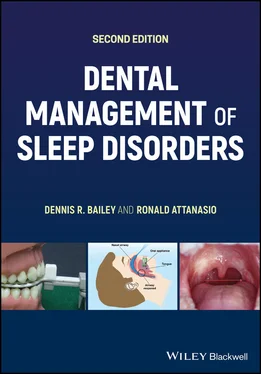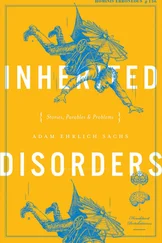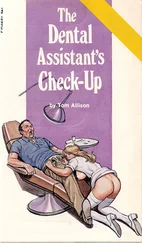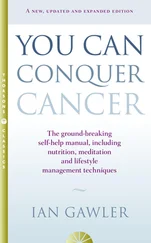Ronald Attanasio - Dental Management of Sleep Disorders
Здесь есть возможность читать онлайн «Ronald Attanasio - Dental Management of Sleep Disorders» — ознакомительный отрывок электронной книги совершенно бесплатно, а после прочтения отрывка купить полную версию. В некоторых случаях можно слушать аудио, скачать через торрент в формате fb2 и присутствует краткое содержание. Жанр: unrecognised, на английском языке. Описание произведения, (предисловие) а так же отзывы посетителей доступны на портале библиотеки ЛибКат.
- Название:Dental Management of Sleep Disorders
- Автор:
- Жанр:
- Год:неизвестен
- ISBN:нет данных
- Рейтинг книги:3 / 5. Голосов: 1
-
Избранное:Добавить в избранное
- Отзывы:
-
Ваша оценка:
- 60
- 1
- 2
- 3
- 4
- 5
Dental Management of Sleep Disorders: краткое содержание, описание и аннотация
Предлагаем к чтению аннотацию, описание, краткое содержание или предисловие (зависит от того, что написал сам автор книги «Dental Management of Sleep Disorders»). Если вы не нашли необходимую информацию о книге — напишите в комментариях, мы постараемся отыскать её.
Dental Management of Sleep Disorders
Dental Management of Sleep Disorders, Second Edition
Dental Management of Sleep Disorders — читать онлайн ознакомительный отрывок
Ниже представлен текст книги, разбитый по страницам. Система сохранения места последней прочитанной страницы, позволяет с удобством читать онлайн бесплатно книгу «Dental Management of Sleep Disorders», без необходимости каждый раз заново искать на чём Вы остановились. Поставьте закладку, и сможете в любой момент перейти на страницу, на которой закончили чтение.
Интервал:
Закладка:
The role of dentistry has also been recognized and substantiated by the American Dental Association (ADA), with publication of guidelines in 2017 for screening and the use of OAT. The essence here is that every dentist should be familiar with SRBDs and how to screen for them as well as in the use of oral appliances (OAs). The second edition of this textbook is intended to meet and even exceed those objectives. This edition is intended as a basic understanding of sleep, sleep disorders, the role of the dentist, the use of oral appliances, and to also become familiar with other options for the management of the SRBD. Conceptually, this edition is intended for those seeking a basic understanding of sleep as well as the more common sleep disorders. It is applicable to anyone wishing to learn more, from the dental student to those in a postdoctoral program and for the practicing dentist or hygienist. More importantly the intent is for this edition to offer information and guidance that is clinically applicable. This involves the screening process, the clinical evaluation, and the use of OAT.
The second edition is an expanded version of the first edition. The explosion of information and evidence since the first edition was released has been important for this current edition. This edition has been broken down into five sections that will allow the reader to focus on a particular area that may be of particular interest. Additionally, this edition involved contributing authors with expertise in their respective discipline of interest to enhance that specific chapter and provide a higher level of evidence. Throughout the book and in the appendix a variety of documents for screening as well as tracking patient progress have been referenced or created to aid the practitioner with their involvement in this discipline. It is important for the reader and student to realize that even though the dentist may not be involved in the management of most of the sleep disorders reviewed, it is important to be familiar with many simply to improve patient care and one’s quality of life.
A text such as this involves many people. The contributing authors; the staff at Wiley‐Blackwell, especially Tanya, Erica, and Krishna; and the many people who contribute to the production of this second edition. Recognition of the many people in research, education, and practice who publish the information used as a basis for the creation of each chapter have also impacted a text such as this one. Hopefully this edition will act as the catalyst for continued education and learning that involves sleep medicine resulting in improved health and quality of life for the patients we serve.
Dennis R. Bailey, DDS, FAGD, D,ABOP, D,ABDSM
Ronald Attanasio, DDS, MSEd, MS
Section 1 Overview of Sleep Medicine
This section provides an overview of sleep medicine specifically as it applies to the practice of dentistry and in particular to anyone interested in becoming involved in this discipline or those already involved with the desire to develop and include this in their practice. In this section, there is a discussion related not only to the science of sleep medicine but also to the recognition that many of the patients who are seen daily may be at risk for a sleep disorder, based on history as well as conditions that the dentist encounters daily, with an emphasis on sleep‐related breathing disorders (snoring and sleep apnea). Additionally, the need to understand the impact sleep disorders have on our everyday life is discussed along with the wide variety of sleep disorders that exist and may go undetected.
This discipline is very dynamic. There are areas that are of interest and will continue to develop over time. Areas to monitor in the future are:
The developing statistics relative to prevalence.
Understanding the role of neurotransmitters in sleep as research discovers their expanding role and interaction.
Developing understanding of the gut microbiome related not only to sleep but also to many other health‐related consequences.
1 Impact of Sleep Disorders on Society
Conceptual Overview
Sleep disorders can no longer be thought of as simply having a poor night's sleep. At the current time, there are a large number of different sleep disorders that may affect one's quality of life (QOL). In addition, there is a difference between the sleep state and the wake state. Sleep is not simply an altered state of consciousness. In other words, it is not simply a matter of being asleep or being awake. Sleep is a totally separate behavioral and physiologic state that is unique and well documented. Carskadon and Dement define sleep in this way: “Sleep is a reversible behavioral state of perpetual disengagement from and unresponsiveness to the environment” [1]. As such sleep is a combination of rapid eye movement (REM) and non‐rapid eye movement (NREM) sleep associated with well defined and variable brain activity [2].
Sleep disruption and the specifically recognized sleep disorder may have a major impact on one's well‐being, health status, and even QOL. There may also be other associated public health concerns that are related to accidents, mortality, morbidity, utilization of healthcare, executive function, and routine daily tasks. Therefore, as good sleep may have a positive impact on one's life, the presence of a sleep disorder may have the opposite effect.
The Evolution of Sleep in Modern Times
Sleep was not always as we know it today or have known it for over 100 years. Prior to the industrial revolution, sleep and wakefulness were mostly predicated by the rising and setting of the sun. When the industrial revolution occurred, the 24‐hour day was broken down into three 8‐hour periods: one for work, one for sleep, and the other one for pleasure and other activities. Prior to this time, sleep was typically broken down into two stages or shifts and was referred to as “segmented sleep” [3]. These were referred to as first and second sleep or alternatively as “dead sleep” and “morning sleep.” Between these two was a period referred to as “the watching,” which was a period of wakefulness that would last for an hour or even longer in some situations. Furthermore, the eight‐hour uninterrupted period of sleep became more common because of the use of supplemental light that resulted in bedtimes that became later and as such the period between the two stages eventually disappeared.
As sleep became more like we know it today, as is explained in a book by Benjamin Reiss [4], the industrial age changed many things. Where people would sleep in a communal manner, they now would have separate bedrooms. More importantly, sleep disorders that we recognize today most likely were being recognized and became more prevalent.
Another example was Henry David Thoreau's Walden . This was produced when he decided to abandon the sleep pattern of the day and return to one from the past. This led to a time of creativity that had not previously been experienced.
As time progressed, other changes in society were taking place that ultimately would impact our circadian clock and our sleep. One such change was in 1910 when standardized time zones were established, mainly because of the need for railroads to synchronize schedules. Today many changes related to modernization and technology are all in some way impacting our sleep.
Epidemiology and Prevalence of Sleep Disorders
The origin and onset of a specific sleep disorder is often multifactorial. Epidemiology as it applies here is the study of a particular sleep disorder and how it impacts the overall health of the patient. By definition, epidemiology is the study of the occurrence of a particular disorder and how it impacts the health as well as the diseases of different and varying populations [5]. It is basically the foundation for public health. A text specific to the study of epidemiology has defined the four major concerns associated with this [6].
Читать дальшеИнтервал:
Закладка:
Похожие книги на «Dental Management of Sleep Disorders»
Представляем Вашему вниманию похожие книги на «Dental Management of Sleep Disorders» списком для выбора. Мы отобрали схожую по названию и смыслу литературу в надежде предоставить читателям больше вариантов отыскать новые, интересные, ещё непрочитанные произведения.
Обсуждение, отзывы о книге «Dental Management of Sleep Disorders» и просто собственные мнения читателей. Оставьте ваши комментарии, напишите, что Вы думаете о произведении, его смысле или главных героях. Укажите что конкретно понравилось, а что нет, и почему Вы так считаете.











